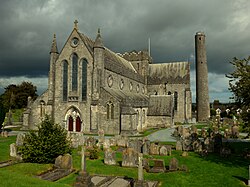Irishtown, County Kilkenny
| Irishtown | |
| County Kilkenny | |
|---|---|
 St Canice’s Cathedral, Irishtown | |
| Location | |
| Grid reference: | S503564 |
| Location: | 52°39’24"N, 7°15’26"W |
| Data | |
| Local Government | |
Irishtown is an old borough which has become a neighbourhood of Kilkenny in County Kilkenny. Largely indistinguishable today, it is the area around St Canice's Cathedral. The borough was also called Newcourt or St Canice's, and was separated by the River Breagagh from the walled town of Kilkenny to the south.
The historic neighbourhood retains a distinctive local character within the modern city of Kilkenny.[1] The street leading south from the Cathedral to the Breagagh is called 'Irishtown'.
History

The site of Irishtown was the capital of the Mac Giolla Phádraig dynasty of the mediæval Kingdom of Ossory, and a daughter house of Aghaboe Abbey was built there. In 1111 the Synod of Ráth Breasail divided Ireland into dioceses, with the Diocese of Ossory based on the Gaelic kingdom and the abbey church became St Canice's Cathedral.[2]
The name Kilkenny is itself from the Irish Cill Chainnigh meaning 'Church of St Canice'. The status of episcopal seat spurred the growth of the existing settlement. After the Norman invasion of Ireland, the Normans built Kilkenny Castle nearby as the seat of the new County of Kilkenny, which had largely the same extent as the Kingdom of Ossory. Two separate boroughs were recognised: the "English Town" or "High Town" of the colonists around the Castle, and the Gaelic "Irish Town" around the Cathedral.[3] When County Kilkenny was a liberty with a seneschal, the English borough of Kilkenny was within it, but the precincts of the cathedral were excluded from the liberty, in the "crosslands" (church ground) subject to the sheriff of County Dublin.[4]
Kilkenny and Irishtown were both walled towns with separate walls, and connected by Watergate Bridge over the Breagagh. Irishtown was the poorer borough. The members of the borough corporation were clergy in the diocese.[5]
In 1609, Kilkenny borough was made a city, administratively separate from the authorities of County Kilkenny, with its own sheriff and grand jury, and the borough of Irishtown in the parish of St Canice was allocated to the liberties of the new city.
It was through Dean's Gate in 1650 that Cromwell's army entered Irishtown and from there captured Kilkenny, capital of Confederate Ireland.[6]
St Canice Borough was a borough represented in the House of Commons of Ireland, separate from Kilkenny City. The latter was in the direct control of the Earl of Ormond, whereas the patron of St Canice was the Bishop of Ossory in the established Church of Ireland. Since the power of appointing the bishop was in the gift of the Earl of Ormond, the practical difference was slight. Although St Canice Borough was disfranchised at the Acts of Union 1800, the borough corporation remained separate from that of Kilkenny until the Municipal Corporations (Ireland) Act 1840. That Act abolished both of the corporations and appointed the town commissioners of Kilkenny borough as successors to both, and defined new limits of the borough of Kilkenny, which included all the land of both predecessor boroughs. The Irishtown corporation records were transferred to the Kilkenny Tholsel.
In 1846, the Parliamentary Gazetteer wrote:
The city all stands on the right bank of the Nore, and is cut by the Bregah rivulet into the two great sections of Irishtown and Englishtown, or of the more ancient and the less ancient Kilkenny ... Irishtown on the north of the Bregah, and Englishtown on the south, though formerly regarded as distinct towns, and even possessing separate charters and corporations, are now both topographically and politically fused into each other, so as to form in the strictest sense one town; and except that each possesses remains of its originally distinctive character, and boasts as a pre-eminent feature its peculiar metropolitical edifice, the former in St. Canice cathedral on a hill or rising ground in the north, and the latter in Kilkenny-castle on a hill or rising ground in the south-east, they could not possibly be suspected by even a dabbler in Irish antiquities, who should happen to be ignorant of their particular history, to have ever been in any manner mutually distinct.—[7]
References
- ↑ Gerard-Sharp, Lisa; Perry, Tim; Publishing, Dk (2012-03-01). "Street by street: Kilkenny". DK Eyewitness Travel Guide: Ireland. Dorling Kindersley Limited. p. 144. ISBN 9781405393263. https://books.google.com/books?id=0kyvXgXCuawC&pg=PA144. Retrieved 1 August 2013.
- ↑ Bradley, John (2015). "Pulp Facts and Core Fictions; Translating a Cathedral from Aghaboe to Kilkenny". Clerics, Kings and Vikings: Essays on Mediæval Ireland in Honour of Donnchadh Ó Corráin. Four Courts Press. pp. 169–184. ISBN 9781846822797.
- ↑ "A Brief History of Kilkenny City". Kilkenny 400. http://kilkenny400.ie/?page_id=46.
- ↑ Barry, Siuban; Bradley, John; Empey, Adrian (1985). A worthy foundation: the cathedral church of St. Canice, Kilkenny, 1285-1985 : essays. Dolmen Press. ISBN 9780851054353.
- ↑ "Constituencies: St Canice or Irishtown". History of the Irish Parliament. Ulster Historical Foundation. http://www.ancestryireland.com/history-of-the-irish-parliament/constituencies/st-canice-or-irishtown/.
- ↑ Fitzgerald, John (18 September 2008). "Cromwell Attacks Kilkenny". Kilkenny Advertiser. http://www.advertiser.ie/kilkenny/article/2028.
- ↑ Parliamentary Gazetteer (1846) "Kilkenny [city]" p.432
- Bradley, John (5 October 2016). "no. 10, Kilkenny" (in en). Dublin: Royal Irish Academy. https://www.ria.ie/irish-historic-towns-atlas-online-kilkenny.
- First Report: Appendix, part I (South-eastern and Part of North-eastern circuit): Commissioners on Municipal Corporations in Ireland (HMSO, 1835)
- The Parliamentary Gazetteer of Ireland: Adapted to the New Poor-law, Franchise, Municipal and Ecclesiastical Arrangements, and Compiled with a Special Reference to the Lines of Railroad and Canal Communication, as Existing in 1844–45. Vol.2: D–M. A. Fullarton and Company. 1846. https://books.google.com/books?id=4iK5_B7W1xIC.
Books
- Ainsworth, John (1978). "Corporation Book of the Irishtown of Kilkenny, 1537-1628". Analecta Hibernica (Irish Manuscripts Commission) (28): 1, 3–78.